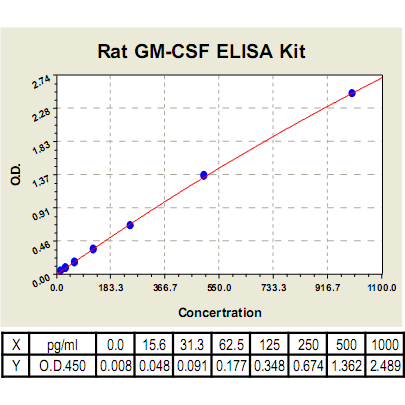Product Sheet CL0366
Description
BACKGROUND Granulocyte macrophage-colony stimulating factor (GM-CSF) is a a 22 kDa monomeric cytokine of colony-stimulating factor family and secreted by macrophages, T cells, mast cells, endothelial cells and fibroblasts. It was originally defined by its ability to generate in vitro granulocyte and macrophage colonies from bone marrow precursor cells. GM-CSF also controls dendritic cell and T-cell function, thus linking innate and acquired immunity.1 Because of the widespread expression of the GM-CSF receptor in hematopoietic cells, it was assumed that both GM-CSF and its receptor were key players in the regulation of steady-state functions. Deletion of either the GM-CSF gene or its receptor showed no obvious deficiency in myeloid cell numbers or production. Rather, a growing body of evidence now suggests that GM-CSF plays a key role in signaling emergency hemopoiesis (predominantly myelopoiesis) in response to infection, including the production of granulocytes and macrophages in the bone marrow and their maintenance, survival, and functional activation at sites of injury or insult. The role of GM-CSF and its receptor in pathology, on the other hand, arises largely as a result of abnormal signaling leading to deregulated myelopoiesis with enhanced proliferation and survival of myeloid precursors, a common feature of myeloproliferative disorders and myeloid leukemias. In addition to its role in hematologic neoplasia, studies with human patients and animal models of disease have now confirmed that GM-CSF is a central player in the cytokine network associated with inflammatory and autoimmune conditions.2
The GM-CSF receptor is a heterodimer that comprises a major binding subunit (GMRalpha) and a major signaling subunit (betac). GM-CSF receptor activation follows general rules observed for other class I cytokine receptors that invoke receptor dimerization and tyrosine transphosphorylation of cytoplasmic domains. The GM-CSF receptor does not have intrinsic tyrosine kinase activity, but associates with the tyrosine kinase Jak2 that is required for betac transphosphorylation and the initiation of signaling and biological activity. The cytoplasmic domains of both GMRalpha and betac are essential for receptor activation, but only betac associates with Jak2. GM-CSF receptor activation is initiated by the low-affinity interaction of GM-CSF with GMRalpha chain to form a binary complex. Recruitment of the binary complex to preformed betac dimers generates a 2:2:2 hexameric complex and converts GM-CSF binding to high affinity. Oligomerization of the hexamer complex generates a higher order dodecamer complex that is required for receptor tyrosine phosphorylation in trans by associated Jak2 and initiates intracellular signal transduction. Importantly, the biochemical effects of GM-CSF signaling at different concentrations have been determined and have also been shown to be separable. Low pM concentrations of GM-CSF mediate betac Ser585 phosphorylation, leading to 14-3-3 binding, PI-3 kinase activation, and hemopoietic cell survival, whereas at concentrations of 10 pM or more, GM-CSF mediates betac Tyr577 phosphorylation, Shc recruitment, and PI-3 kinase activation, thereby promoting both survival and proliferation. Biochemically, Ser585 and Tyr577 phosphorylation are mutually exclusive (Ser585 phosphorylation is extinguished as Tyr phosphorylation comes on) and unidirectional (Ser585 phosphorylation occurs first as GM-CSF concentrations are increased).3 In addition, GM-CSF signaling also regulates the activity of Bcl-2 family members.4
The GM-CSF receptor is a heterodimer that comprises a major binding subunit (GMRalpha) and a major signaling subunit (betac). GM-CSF receptor activation follows general rules observed for other class I cytokine receptors that invoke receptor dimerization and tyrosine transphosphorylation of cytoplasmic domains. The GM-CSF receptor does not have intrinsic tyrosine kinase activity, but associates with the tyrosine kinase Jak2 that is required for betac transphosphorylation and the initiation of signaling and biological activity. The cytoplasmic domains of both GMRalpha and betac are essential for receptor activation, but only betac associates with Jak2. GM-CSF receptor activation is initiated by the low-affinity interaction of GM-CSF with GMRalpha chain to form a binary complex. Recruitment of the binary complex to preformed betac dimers generates a 2:2:2 hexameric complex and converts GM-CSF binding to high affinity. Oligomerization of the hexamer complex generates a higher order dodecamer complex that is required for receptor tyrosine phosphorylation in trans by associated Jak2 and initiates intracellular signal transduction. Importantly, the biochemical effects of GM-CSF signaling at different concentrations have been determined and have also been shown to be separable. Low pM concentrations of GM-CSF mediate betac Ser585 phosphorylation, leading to 14-3-3 binding, PI-3 kinase activation, and hemopoietic cell survival, whereas at concentrations of 10 pM or more, GM-CSF mediates betac Tyr577 phosphorylation, Shc recruitment, and PI-3 kinase activation, thereby promoting both survival and proliferation. Biochemically, Ser585 and Tyr577 phosphorylation are mutually exclusive (Ser585 phosphorylation is extinguished as Tyr phosphorylation comes on) and unidirectional (Ser585 phosphorylation occurs first as GM-CSF concentrations are increased).3 In addition, GM-CSF signaling also regulates the activity of Bcl-2 family members.4
REFERENCES
1. Hamilton, J.A. & Anderson, G.P.: Growth Factors 22:225-31, 2004
2. Hamilton, J.A.: Trends Immunol. 23:403-8, 2002
3. Hercus, T.R. et al: Blood 114, :1289-98, 2009
4. Chao, J-R. et al: Mol. Biol. Cell. 18:4883–98, 1998
2. Hamilton, J.A.: Trends Immunol. 23:403-8, 2002
3. Hercus, T.R. et al: Blood 114, :1289-98, 2009
4. Chao, J-R. et al: Mol. Biol. Cell. 18:4883–98, 1998
Products are for research use only. They are not intended for human, animal, or diagnostic applications.
Details
Cat.No.: | CL0366 |
Target Protein Species: | Rat |
Range: | 156pg/ml-10,000pg/ml |
Specificity: | No detectable cross-reactivity with any other cytokine. |
Storage: | Store at 4°C. Use within 6 months. |
ELISA Kits are based on standard sandwich enzyme-linked immunosorbent assay technology. Freshly prepared standards, samples, and solutions are recommended for best results.
Products
| Product | Size | CAT.# | Price | Quantity |
|---|---|---|---|---|
| Rat GM-CSF ELISA Kit: Rat Granulocyte Macrophage-Colony Stimulating Factor ELISA Kit | Size: 96 Wells | CAT.#: CL0366 | Price: $511.00 |

